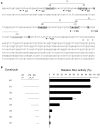Development of Tools for Genetic Analysis of Phenanthrene Degradation and Nanopod Production by Delftia sp. Cs1-4
- PMID: 22016746
- PMCID: PMC3191457
- DOI: 10.3389/fmicb.2011.00187
Development of Tools for Genetic Analysis of Phenanthrene Degradation and Nanopod Production by Delftia sp. Cs1-4
Abstract
The bacterium Delftia sp. Cs1-4 produces novel extracellular structures (nanopods) in conjunction with its growth on phenanthrene. While a full genome sequence is available for strain Cs1-4, genetic tools that could be applied to study phenanthrene degradation/nanopod production have not been reported. Thus, the objectives of this study were to establish such tools, and apply them for molecular analysis of nanopod formation or phenanthrene degradation. Three types of tools were developed or validated. First, we developed a new expression system based on a strong promoter controlling expression of a surface layer protein (NpdA) from Delftia sp. Cs1-4, which was ca. 2,500-fold stronger than the widely used lactose promoter. Second, the Cre-loxP system was validated for generation of markerless, in-frame, gene deletions, and for in-frame gene insertions. The gene deletion function was applied to examine potential roles in nanopod formation of three genes (omp32, lasI, and hcp), while the gene insertion function was used for reporter gene tagging of npdA. Lastly, pMiniHimar was modified to enhance gene recovery and mutant analysis in genome-wide transposon mutagenesis. Application of the latter to strain Cs1-4, revealed several new genes with potential roles in phenanthrene degradation or npdA expression. Collectively, the availability of these tools has opened new avenues of investigation in Delftia sp. Cs1-4 and other related genera/species with importance in environmental toxicology.
Keywords: Delftia sp. Cs1-4; biodegradation; genetic manipulation; nanopods; phenanthrene; polynuclear aromatic hydrocarbons; surface layer protein.
Figures



Similar articles
-
The phn Island: A New Genomic Island Encoding Catabolism of Polynuclear Aromatic Hydrocarbons.Front Microbiol. 2012 Apr 4;3:125. doi: 10.3389/fmicb.2012.00125. eCollection 2012. Front Microbiol. 2012. PMID: 22493593 Free PMC article.
-
Effects of outer membrane vesicle formation, surface-layer production and nanopod development on the metabolism of phenanthrene by Delftia acidovorans Cs1-4.PLoS One. 2014 Mar 18;9(3):e92143. doi: 10.1371/journal.pone.0092143. eCollection 2014. PLoS One. 2014. PMID: 24642639 Free PMC article.
-
Nanopods: a new bacterial structure and mechanism for deployment of outer membrane vesicles.PLoS One. 2011;6(6):e20725. doi: 10.1371/journal.pone.0020725. Epub 2011 Jun 7. PLoS One. 2011. PMID: 21687732 Free PMC article.
-
Complete genome sequence of the phenanthrene-degrading soil bacterium Delftia acidovorans Cs1-4.Stand Genomic Sci. 2015 Aug 15;10:55. doi: 10.1186/s40793-015-0041-x. eCollection 2015. Stand Genomic Sci. 2015. PMID: 26380642 Free PMC article.
-
Identification of NpdA as the protein forming the surface layer in Paracidovorax citrulli and evidence of its occurrence as a surface layer protein in diverse genera of the Betaproteobacteria and Gammaproteobacteria.Access Microbiol. 2023 Dec 11;5(12):000685.v3. doi: 10.1099/acmi.0.000685.v3. eCollection 2023. Access Microbiol. 2023. PMID: 38188235 Free PMC article.
Cited by
-
Genomic, Physiologic, and Symbiotic Characterization of Serratia marcescens Strains Isolated from the Mosquito Anopheles stephensi.Front Microbiol. 2017 Aug 10;8:1483. doi: 10.3389/fmicb.2017.01483. eCollection 2017. Front Microbiol. 2017. PMID: 28861046 Free PMC article.
-
Elizabethkingia anophelis: molecular manipulation and interactions with mosquito hosts.Appl Environ Microbiol. 2015 Mar;81(6):2233-43. doi: 10.1128/AEM.03733-14. Epub 2015 Jan 16. Appl Environ Microbiol. 2015. PMID: 25595771 Free PMC article.
-
Onion Thrips (Thysanoptera: Thripidae) Feeding Promotes Infection By Pantoea ananatis in Onion.J Econ Entomol. 2017 Dec 5;110(6):2301-2307. doi: 10.1093/jee/tox273. J Econ Entomol. 2017. PMID: 29112728 Free PMC article.
-
The phn Island: A New Genomic Island Encoding Catabolism of Polynuclear Aromatic Hydrocarbons.Front Microbiol. 2012 Apr 4;3:125. doi: 10.3389/fmicb.2012.00125. eCollection 2012. Front Microbiol. 2012. PMID: 22493593 Free PMC article.
-
The genomic study of an environmental isolate of Scedosporium apiospermum shows its metabolic potential to degrade hydrocarbons.Stand Genomic Sci. 2017 Dec 4;12:71. doi: 10.1186/s40793-017-0287-6. eCollection 2017. Stand Genomic Sci. 2017. PMID: 29225727 Free PMC article.
References
LinkOut - more resources
Full Text Sources
Miscellaneous

